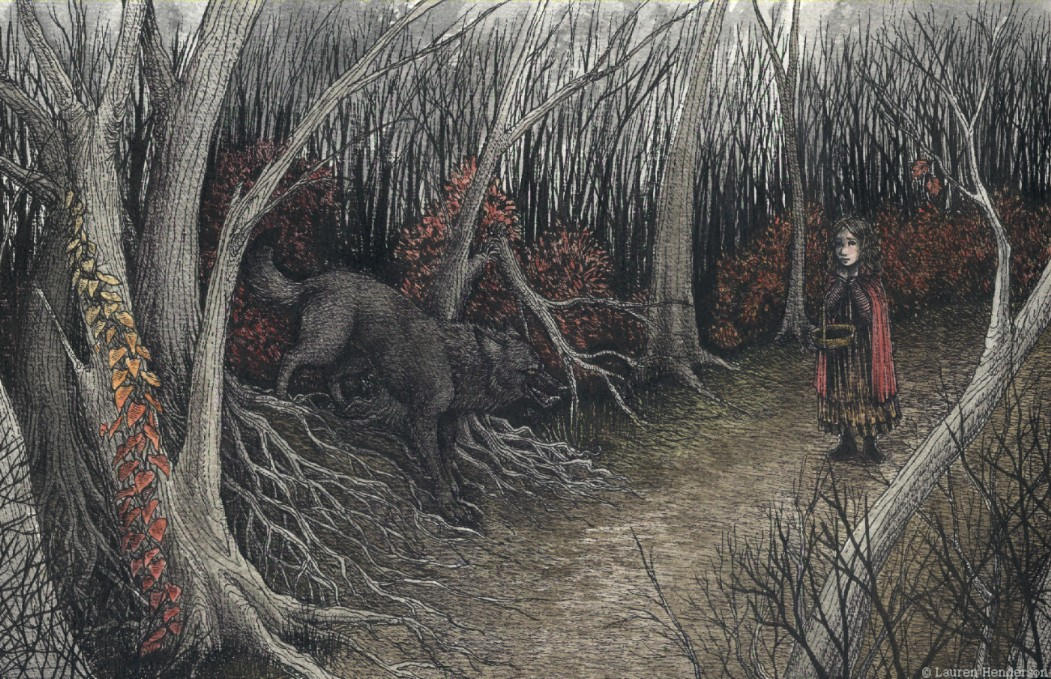 |
| Little girl v. big, bad danger. Illustration by Lauren Henderson. |
There are always different versions of the 'same' fairy tale, and Little Red Riding Hood is no exception. French author Charles Perrault and one side of the Brothers Grimm (Wilhelm) both adapted their own stories from German, Polish, Italian, Austrian, and French versions that cropped up sporadically throughout Europe in the 10th and 14th centuries. It has gone by many different names, most familiarly The False Grandmother, which could possibly to explain why some renditions feature hoods v. caps v. other types of headgear of various colours (Charles Marelles rewrote the story entirely, changing the hood to yellow/gold). The whole colour thing is interesting when you consider del Toro's lighting preferences when separating 1944 fascist Spain with the fairy-tale and underground worlds, or even Ofelia's red shoes with that of Red's whatever-she-happens-to-be-wearing. Anyway...
I had to indulge my history support and aesthetic validation there for a few moments, but enough context. The earliest recorded written account of the folktale lies with Perrault, and it just so happens that it fits quite well with del Toro's film. For starters, both stories begin with the age-old line "Once upon a time..."
There lived a little country girl who was doted on by her mother and grandmother [Ofelia moves to the country with her single parent]. The mother made her daughter a red hood [Ofelia's mother made her a dress]. One day, the mother sent Red to her grandmother's house because she was ill [the mother's poor pregnancy]. So, taking along some confectionery [Remember the Pale Man's banquet? Of course you do.] the little girl went on her way through the woods [for Ofelia, the labyrinth].
As she walked, Red met a wolf [in the film, this changes from the trickster faun to the evil stepfather]. The wolf wanted to eat her but could not for fear of nearby woodcutters [the resistance]. Instead, he made light conversation with the young girl and asked where she was headed off to in such a hurry. Oddly unafraid, she answered by telling him about her sick grandmother in the next village...disclosing the exact location of her house. -_- She told the wolf that it was nestled just past a mill [which is where most of the events of the film take place].
 |
| Intermission image, cuz it's beautiful and dark, the paragraphs were too many... and I do what I want. Illustration by Noctillucca. |
The wolf takes his leave, rushing off to go eat the grandmother and wait for Red to show up so he can consume her as well [Pale Man again *shudder*]. Red gets distracted by butterflies [Ofelia by faeries] and decides it would be a grand idea to gather some nuts and little bouquets of wildflowers [Red goofs around three times, Ofelia completes three tasks]. Meanwhile, the wolf has arrived at the house and lies to the grandmother about his identity in order to gain entry [much like the faun's lies to Ofelia, although his reasoning is much more sound]. He eats her alive because he's starving—hadn't eaten in three days, apparently. >_>
Enter Red. The wolf, now disguised as the grandmother in the sickbed, asks the girl to join him, which she oh-so stupidly does. This bit strays from Pan's Labyrinth in that Ofelia is no where near so gosh-darned dumb. Well, apart from when she eats the two grapes despite being expressly told not to. Siiigh.
Anyway, this is when Red makes remarks about her 'grandmother's' big arms, legs, ears, eyes, and teeth. The wolf responds with light remarks in an attempt to make her complacent, but eventually gets bored with the mind games and eats her whole [Ofelia's death brought about by her stepfather, the Captain, or a direct reflection of the Pale Man's terrifying eating habits]. Some versions end with a wood cutter or group of lumberjacks bursting into the grandmother's cottage to kill the wicked wolf, and I suppose that could be taken as the Spanish rebels surrounding the mill and shooting the Captain in the face. [He totes deserved that.]
End-of-story-moral-wise, Ofelia differs from Red in that she learned independence and bravery rather than how to hide from dangerous strangers along isolated forest paths.
 |
| Illustration at left by Arthur Rackham. Uterus-shaped Moribund Tree at right by del Toro. |
With both stories we get the rule of three, a nature-setting (see the above images), characters with similar, er, characteristics, allusions to virginity/ menstruation/ coming-of-age (again, look at the above image and try to unsee the feminine similarity), and all that good stuff. I will analyze these things—and more!—in the next post.
For more information:
No comments:
Post a Comment
Note: Only a member of this blog may post a comment.